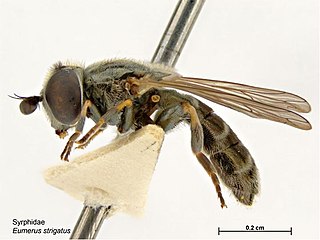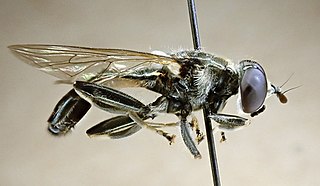
Hoverflies, also called flower flies or syrphids, make up the insect family Syrphidae. As their common name suggests, they are often seen hovering or nectaring at flowers; the adults of many species feed mainly on nectar and pollen, while the larvae (maggots) eat a wide range of foods. In some species, the larvae are saprotrophs, eating decaying plant and animal matter in the soil or in ponds and streams. In other species, the larvae are insectivores, preying on aphids, thrips, and other plant-sucking insects.

Syritta pipiens, sometimes called the thick-legged hoverfly, is one of the most common species in the insect family Syrphidae. This fly originates from Europe and is currently distributed across Eurasia and North America. They are fast and nimble fliers, and their larvae are found in wet, rotting organic matter such as garden compost, manure, and silage. The species is also commonly found in human-created environments such as most farmland, gardens, and urban parks, wherever there are flowers. This species is an important part of its native ecosystem as adult Syritta pipiens flies are critical pollinators for a variety of flowering plants and the species supports parasitism by various parasitic wasp species. Thus, they play an important role in environmental functionality, and can serve as bio-indicators, in which their abundance can reflect the health of the environment. Syritta pipiens looks like many predatory hoverfly species, yet is not predatory.

Eumerus strigatus, the onion bulb fly, is a fairly common species of syrphid fly observed across Europe. Also found in north-central North America and other scattered locations as an introduced species from infested bulbs. Syrphid flies are also known as hover flies or flower flies because the adults are frequently found hovering around flowers from which they feed on nectar and pollen. The larvae feed on various bulbs.

Liparis liliifolia, known as the brown widelip orchid, lily-leaved twayblade, large twayblade, and mauve sleekwort, is a species of orchid native to eastern Canada and the eastern United States. It can be found in a variety of habitats, such as forests, shrublands, thickets, woodlands, and mountains. The orchid is considered globally secure, but it is considered rare or endangered in many northeastern states.

Teuchocnemis lituratus,, the Black Spur Fly, is an uncommon species of syrphid fly observed in the eastern half of North America. Syrphid flies are also known as Hover Flies or Flower Flies because the adults are frequently found hovering around flowers from which they feed on nectar and pollen. Adults are 10.5–15.4 mm (0.41–0.61 in)long, black with a yellow scutellum and hind tibia of male with spike. The larvae are unknown.

Somula decora, commonly known as the spotted wood fly, is an uncommon species of syrphid fly observed in central to eastern North America. Hoverflies can remain nearly motionless in flight. The adults are also known as flower flies for they are commonly found on flowers, from which they get both energy-giving nectar and protein-rich pollen. The larvae live in decaying wood.

Chalcosyrphus (Xylotomima) inarmatus, the Yellow-haired Leafwalker, is an uncommon species of syrphid fly found across northern North America. Hoverflies are able to remain nearly motionless in flight. The adults are also known as flower flies for they are commonly found around and on flowers, from which they get both energy-giving nectar and protein-rich pollen.

Tropidia quadrata, commonly known as the common thickleg fly, is a common species of syrphid fly observed across the north-central United states and southern Canada. Hoverflies can remain nearly motionless in flight. The adults are also known as flower flies for they are commonly found on flowers, from which they get both energy-giving nectar and protein rich pollen. The larvae are aquatic.
' Paragus angustifrons, the Narrow-faced Grass Skimmer, is an uncommon species of syrphid fly observed throughout North America. Hoverflies can remain nearly motionless in flight. The adults are also known as flower flies for they are commonly found on flowers from which they get both energy-giving nectar and protein-rich pollen. The larvae have been reared from Aphis spiraecola and Aphis spiraephila.

Eristalis dimidiata, the black-shouldered drone fly, is a species of hoverfly native to much of Canada and the eastern and northern United States. It flies year-round in southern areas and from late March to mid-November further north. It is one of the earliest hoverflies to fly in the spring, and as such likely overwinters as an adult. It lives primarily in forests.

Temnostoma venustum , the Black-banded Falsehorn , is a rare species of syrphid fly observed in the northeastern United States and adjacent Canada. Hoverflies can remain nearly motionless in flight. The adults are also known as flower flies for they are commonly found on flowers, from which they get both energy-giving nectar and protein rich pollen. Temnostoma adults are strong wasp mimics The larvae burrow in moist decayed wood.
Criorhina nigriventris , the Bare-cheeked Bumble Fly, is an uncommon species of syrphid fly observed across the northern United States, the Appalachian Mountains and southern Canada. Hoverflies can remain nearly motionless in flight. The adults are also known as flower flies for they are commonly found on flowers, from which they get both energy-giving nectar and protein-rich pollen. The larvae of this genus are found in decaying wood.
Chalcosyrphus (Xylotomima) sacawajeae, the Hairy-winged Leafwalker, is a rare species of syrphid fly observed in the Northern United States and Western Canada. Hoverflies can remain nearly motionless while in flight. The adults are also known as flower flies for they are commonly found on flowers, from which they get both energy-giving nectar and protein-rich pollen.

Xylota angustiventris,, the Two-spotted Leafwalker , is an uncommon species of syrphid fly observed in northeast North America. Syrphid flies are also known as Hover Flies or Flower Flies because the adults are frequently found hovering around flowers from which they feed on nectar and pollen. Adults are 12.2–14.4 mm (0.48–0.57 in) long, largely black with two yellow spots on the abdomen in the male? The larvae are not known, but in this genus, are likely to be found in tree holes or bark to feed on sap.
Xylota confusa ,, the Confusing Leafwalker , is an uncommon species of syrphid fly observed across Northern North America. Syrphid flies are also known as Hover Flies or Flower Flies because the adults are frequently found hovering around flowers from which they feed on nectar and pollen. Adults are 9.3–12.6 mm (0.37–0.50 in) long. The larvae of this genus live under bark in sap runs.
Xylota naknek , the Naknek Leafwalker , is a fairly common species of syrphid fly observed across Canada and the Northeastern United States. Syrphid flies are also known as Hover Flies or Flower Flies because the adults are frequently found hovering around flowers from which they feed on nectar and pollen. Adults are 9.1–12.8 mm (0.36–0.50 in) long. The larvae of this genus live under bark in sap runs.
Xylota ejuncida ,, the Polished Leafwalker , is a rare species of syrphid fly observed in the eastern North America. Syrphid flies are also known as Hover Flies or Flower Flies because the adults are frequently found hovering around flowers from which they feed on nectar and pollen. Adults are 9.6–10.9 mm (0.38–0.43 in) long. The larvae of this genus live under bark in sap runs.
Platycheirus normae, the paddlearm sedgesitter, is a rare species of syrphid fly observed in northeastern North America. Hoverflies can remain nearly motionless in flight. The adults are also known as flower flies for they are commonly found on flowers, from which they get both energy-giving nectar and protein-rich pollen. Larvae are aphid predators.
Paragus angustistylus, the thin-spined grass skimmer, is a rare species of syrphid fly observed in the Great Lakes Region.. Hoverflies can remain nearly motionless in flight. The adults are also known as flower flies for they are commonly found on flowers, from which they get both energy-giving nectar and protein-rich pollen.
Sphaerophoria asymmetrica , the asymmetric globetail , is a common species of syrphid fly observed across northern North America. Hoverflies can remain nearly motionless in flight. The adults are also known as flower flies for they are commonly found on flowers from which they get both energy-giving nectar and protein rich pollen. The larvae feed on aphids.











